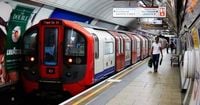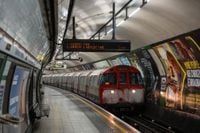London’s morning rush hour on Tuesday, July 1, 2025, was thrown into chaos as a fire alert at South Kensington station led to the suspension and severe disruption of multiple key Tube lines amid an intense heatwave sweeping across the UK.
The entire Circle line was suspended, with no trains running at all, while the District line faced a partial suspension between Embankment and Earl’s Court, coupled with severe delays on the rest of the line. The fire alert also impacted the Hammersmith and City line, which suffered severe delays throughout and a partial suspension between Barking and Liverpool Street.
Transport for London (TfL) confirmed that South Kensington station was closed as emergency services responded to the fire alert. In a statement, TfL said: “District Line: No service between Embankment and Earl’s Court while we respond to a fire alert at South Kensington. Tickets will be accepted on London Buses, C2C, DLR, Mildmay Line, Elizabeth Line and Southwestern Railway services via reasonable routes. Severe delays on the rest of the line.” They also announced that the Circle line was completely suspended while the fire alert was in effect.
The disruption came as London and the wider southeast of England sweltered under a heatwave, with temperatures reaching 33°C in London and a peak of 35°C forecast for the region. East Malling in Kent recorded 33.5°C on the same day, underscoring the intense conditions.
Commuters faced packed platforms and crowded buses as they scrambled to find alternative routes. Pictures from Victoria station showed the westbound platform for the Circle and District lines filled with passengers searching for options. Footage captured at the scene showed trains stalled at platforms with passengers waiting inside, uncertain of when they would depart.
Kate Rice, a senior social platform journalist at Metro, was caught up in the disruption and described the tense atmosphere: “We were just stopped at Sloane Square with an announcement telling us there was a track fire at South Kensington and basically to fend for ourselves. He even laughed while announcing it, saying it was typical British heat.” She added, “The buses were busy after – loads of people emptied the station and onto the street immediately. There was a bit of a scramble to get on my bus with everyone panicking to get to work.”
Further complications were reported on the Northern line, which was part suspended between Tooting Broadway and Morden due to a points failure at Morden station, adding to the morning’s travel woes. Minor delays were also reported on the Elizabeth line, particularly between Whitechapel and Shenfield.
The chaos was compounded by an unrelated points failure at Southall, which suspended service on the Elizabeth line between Paddington and Heathrow Airport, Britain’s busiest airport. This left travellers hoping to escape the heatwave stranded, as trains to the airport were halted.
Transport for London urged passengers to replan their journeys and made clear that tickets on affected lines would be accepted on alternative transport services, including London Buses, C2C, DLR, Mildmay Line, Elizabeth Line, and Southwestern Railway services, provided passengers took reasonable routes.
The fire alert at South Kensington was the pivotal event in the disruptions that rippled across the city’s transport network during the morning rush hour. Though services on the Circle line eventually resumed later in the day, severe delays persisted across the District and Hammersmith and City lines.
London’s transport network, already under strain from soaring temperatures, faced a significant test of resilience as commuters struggled to navigate the sudden and widespread service interruptions. The combination of a fire alert and infrastructure failures highlighted vulnerabilities in the system during extreme weather conditions.
As the heatwave continues, with temperatures expected to remain high, Londoners are bracing for more challenges in their daily commutes. TfL’s response, including acceptance of tickets across multiple alternative services, aimed to mitigate the impact, but the morning’s events underscored the fragility of urban transport infrastructure under pressure.
The morning’s disruptions serve as a reminder of the complex interplay between weather, infrastructure, and emergency incidents in one of the world’s busiest cities. Commuters and officials alike will be watching closely to see how London’s transport system adapts to these growing challenges in the coming days.


